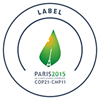�
Our Common Future Under Climate Change
International Scientific Conference 7-10 JULY 2015 Paris, France
From harvesting fields to harvesting energy: A story of local energy transition in Germany
201507-10
By Diana S�sser and Martin D�ring, Helmholtz Zentrum Geesthacht, University of Hamburg
Diana is presenting a poster P-2243-13�Harvesting energy: People's place-based perspective on mitigating climate change with renewable energy technologies at the Social Event on Thursday, July 9th at UPMC and presented it on Wednesday, July 8th at UNESCO.
Energy production and use is still the largest greenhouse gas emitter. Therefore, to decarbonise our energy systems we need to transition our energy generation from fossil fuels to renewable energy, such as solar, wind, geothermics and biomass. However, so far, not enough attention has been given to locally grounded social innovation processes towards a renewable energy transition.
Individuals and communities have increasingly been involved in sustainable energy transition, and regional success stories show that a change is possible.
Over the last two centuries, people became part of community-owned wind parks that harvest wind or invested in solar-installation that harvest sun's rays in order to generate clean electricity and local economic profit. This leads to a shaping of places and transforming of communities to so-called renewable energy communities.
But what social requirements enable local energy transition? How does people's attachment to place and their understanding of climate change shape innovation processes?
To get a people's perspective on community-based energy transition, we interviewed people living in Reu�enk�ge, a coastal municipality on the German North Sea Coast. Over the last two decades, it developed from an average agricultural into a so called 'model-region' for renewable energy generation.�
One of the first wind mills on the German North Sea Coast was built in Reu�enk�ge, and they developed an innovative concept for community-owned wind mills. Over the years, 7 community wind parks were built, 1 solar park and many dwellers installed solar installations and biogas plants. These advancements enables Reu�enk�ge to produce nowadays about 130 times more electricity than they consume.
Investigating place, climate change and local entrepreneurs as analytical units enabled us better understand the place-based social factors behind the transition to renewable energy technologies.
-- Firstly, we found that the people have a strong bonding to their socio-geographic place and a strong identification with their historically shaped landscape. This shapes the people's perception of Reu�enk�ge as innovative place that promotes the local implementation of renewable energy technologies.
-- Secondly, our results indicate a personal, anchored relevance of climate change that goes beyond the perception of threats. Climate change is materialised on renewable energy technologies and it is perceived as catalyst for innovations.
-- Third, local entrepreneurs are innovators, change agents and leaders that identified, evaluated and exploited the opportunities for community-based renewable energy. We found important 8 characteristics of entrepreneurs that promote local innovation processes: identification with the place, responsible behaviour, creation of local profit, challenges and visions, change and distribution, social dialogue and integration, didactic commitment, and strategic management.
With those results, we were able to prove that place, climate change and local entrepreneurs are important analytical units for investigating the process of the local implementation of renewable energy technologies.�
The placed-based perspective proved to be important for a better understanding of local innovation processes and sustainable energy transition. Much more attention must be paid on social requirements and on what we can learn from transitions created on the ground in local communities and regions.�
Diana S�sser is a PhD candidate and Martin D�ring is a researcher within the research project Regional Climate Change (ReKlim) of the German Helmholtz Association. Both doing their research at the Helmholtz-Zentrum Geesthacht, Institute of Coastal Research, and at the University of Hamburg, Institute of Geography, Germany.







